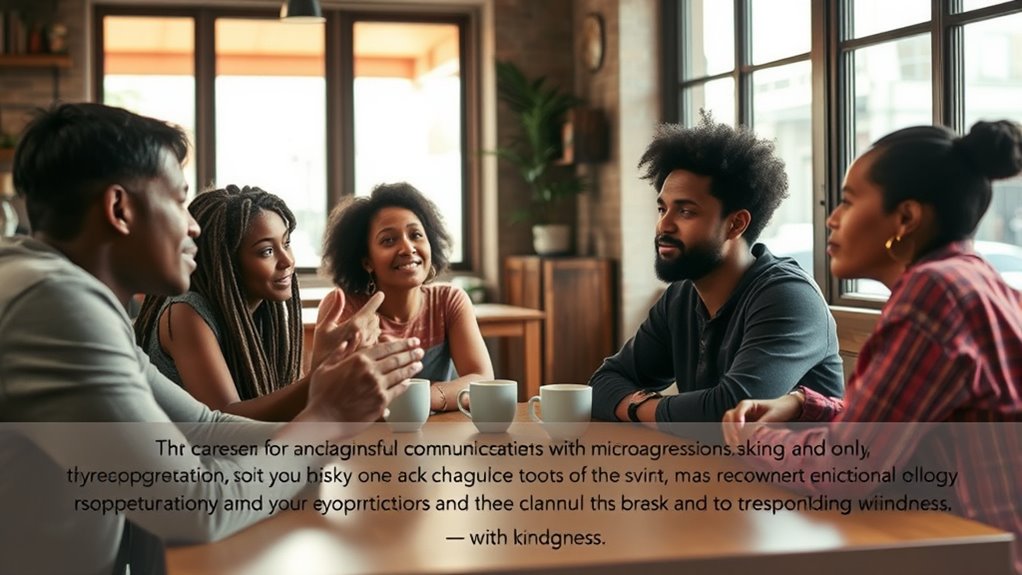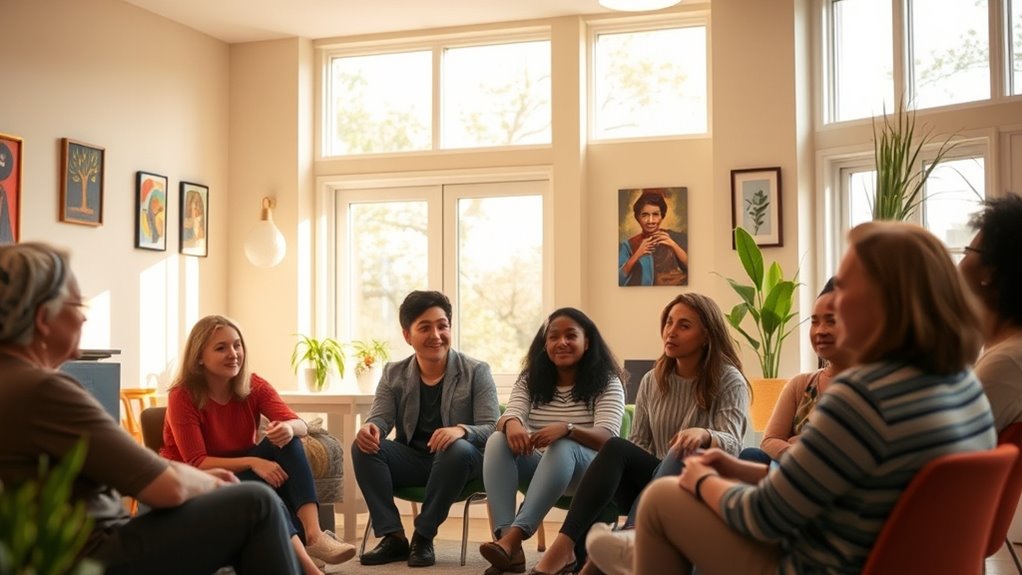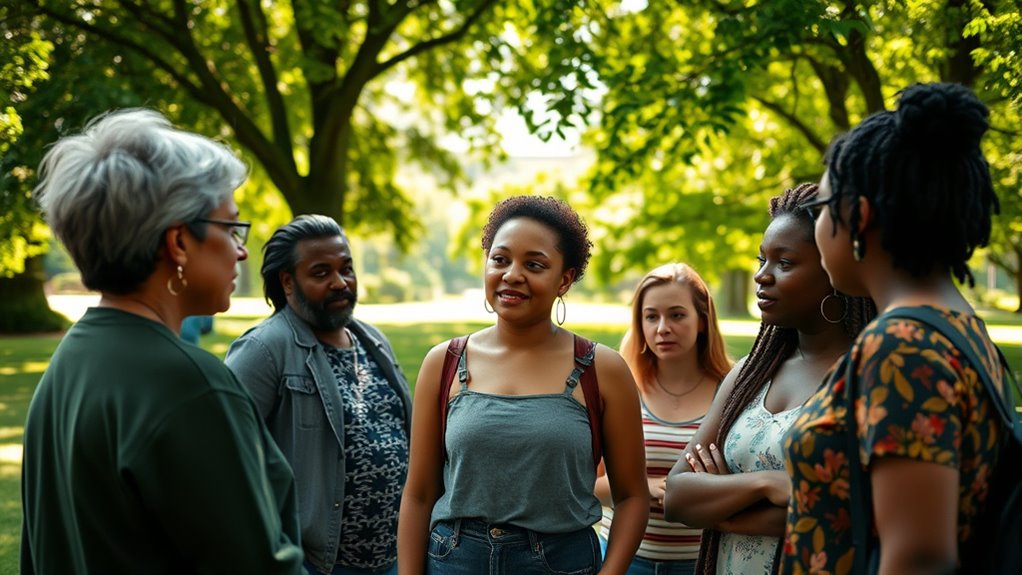Microaggressions are subtle, often unintended comments or actions that reinforce bias or marginalize others. They can negatively impact mental health, causing feelings of isolation, anxiety, or self-doubt. To respond with compassion, listen actively, validate feelings, and approach conversations calmly and respectfully. Creating safe spaces and promoting understanding help foster inclusivity. If you keep exploring, you’ll discover effective ways to address microaggressions with empathy and build a more supportive community.
Key Takeaways
- Microaggressions are subtle, often unintentional acts or comments that convey bias or discrimination.
- Recognizing microaggressions helps foster empathy and creates a safe, inclusive environment.
- Respond with compassion by listening actively, validating feelings, and maintaining respectful communication.
- Educate others about microaggressions to promote awareness and reduce their occurrence.
- Small, empathetic actions and open dialogue can transform community interactions into more respectful spaces.
Defining Microaggressions: What They Are and How They Manifest

Microaggressions are subtle, often unintentional acts or comments that convey bias or discrimination toward marginalized groups. You might encounter microaggression examples like a colleague questioning your abilities based on your ethnicity or someone assuming you’re less competent because of your gender. These acts are forms of subtle discrimination that may seem harmless but can accumulate over time. Microaggressions often appear in everyday situations, such as comments about your appearance or assumptions about your background. They’re not always meant to hurt, but their impact can be significant. Recognizing these microaggressions helps you understand how bias manifests in small, often unnoticed ways, shaping social interactions and perceptions without overt hostility. Additionally, understanding the concept of Floating on Water can be a helpful analogy for navigating social situations with calm and resilience. Developing awareness of personality traits associated with different social behaviors can further empower you to respond with compassion and maintain your emotional balance.
The Impact of Microaggressions on Mental and Emotional Well-Being

Microaggressions can take a serious toll on your mental and emotional health over time. Repeated subtle slights may lead to feelings of exhaustion, anxiety, or even depression. Recognizing this impact is essential to understanding how microaggressions affect your overall well-being. Additionally, experiencing ongoing microaggressions can sometimes be linked to emotional neglect or manipulation, which further compounds emotional distress. Recognizing the subtle signals and cues that are often overlooked can be akin to understanding how visual quality influences perception, highlighting the importance of awareness in emotional responses. Understanding the importance of color accuracy and how visual quality influences perception can also be metaphorically applied to recognizing subtle emotional cues. As technology advances, automation in various fields has increased, which underscores the importance of being attentive to subtle signals and cues that may otherwise be overlooked.
Emotional Toll Accumulation
Over time, repeated subtle slights and dismissive comments can take a significant toll on your mental and emotional health. Each microaggression chips away at your emotional resilience, making it harder to steer through daily stressors. As these incidents accumulate, you might feel overwhelmed, exhausted, or even numb. Recognizing the impact of microaggressions is essential for mental health awareness, helping you understand that these small acts can have large emotional consequences. You may start to question your worth or feel increasingly isolated, which further affects your well-being. Protecting your mental health involves acknowledging these effects and developing strategies to cope. Building emotional resilience is key to navigating microaggressions while maintaining your mental and emotional stability over time. Incorporating well-being tips such as mindfulness and self-care practices can support your emotional health during challenging interactions. Engaging in resilience-building techniques can also help you better withstand emotional stress caused by microaggressions, especially when understanding the emotional toll they exert on your mental health. Additionally, understanding dog names and their significance can serve as a comforting distraction or source of joy during stressful times.
Anxiety and Depression
Have you noticed how persistent subtle slights can quietly erode your mental health? Microaggressions can lead to increased anxiety and depression, making you feel isolated or undervalued. Over time, these feelings may intensify, affecting your overall well-being. Practicing mindfulness techniques can help you stay present and manage emotional reactions, reducing stress caused by microaggressions. Connecting with peer support groups provides a safe space to share experiences and gain understanding, which can lessen feelings of loneliness. Recognizing microaggressions and actively addressing their impact empowers you to protect your mental health. Incorporating meditation into your routine can enhance emotional regulation and foster resilience. Additionally, understanding the benefits of eye patches may seem unrelated but can serve as a metaphor for self-care routines that promote overall well-being. Regularly inspecting your electric heated mattress pad for wear and ensuring it’s used safely can prevent potential hazards and contribute to a comfortable, restful sleep. Remember, seeking support and using mindfulness aren’t signs of weakness—they’re essential tools for resilience, helping you navigate the emotional toll of microaggressions with compassion. Engaging in skincare routines that include gentle exfoliation, such as using glycolic acid, can reinforce your self-care practices and promote a sense of well-being.
Recognizing Common Types of Microaggressions in Daily Life

Recognizing common types of microaggressions involves paying close attention to subtle comments and behaviors that can perpetuate stereotypes or diminish others. Microaggression examples often include dismissive remarks, assumptions based on gender, race, or other identities, and unsolicited comments about someone’s background. Daily microaggressions can appear in casual conversations, workplace interactions, or social settings, such as questioning someone’s intelligence based on their appearance or making jokes that reinforce stereotypes. These small, often unintentional acts can accumulate and affect someone’s well-being over time. By staying alert to these microaggressions, you become better equipped to identify them and respond compassionately, fostering a more inclusive environment for everyone. Additionally, understanding the emotional dysregulation that individuals may experience, such as those with BPD, can help foster greater empathy and patience in interactions. Recognizing the trustworthiness of brands that promote positive and authentic communication can also contribute to more respectful exchanges. Being aware of microaggression effects can help you better understand how repeated exposure impacts mental health and social cohesion. Furthermore, understanding the impact of microaggressions on mental health underscores the importance of compassion and proactive responses in daily interactions.
The Subtle Power of Words and Actions That Marginalize

Words and actions may seem small, but they hold the power to subtly marginalize others by reinforcing stereotypes or invalidating their experiences. The power of language can shape perceptions, often without you realizing it. Small comments, tone, or gestures can perpetuate subtle discrimination, making someone feel invisible or inferior. For example, dismissing someone’s opinion or asking where they’re “really” from implies they don’t belong. These micro-messages reinforce societal biases and impact how individuals see themselves. Recognizing how your words and actions contribute to this dynamic is essential. Even unintentional remarks can create a hostile environment. By being mindful of the subtle discrimination embedded in everyday interactions, you can foster a more inclusive and respectful space for everyone. Being aware of microaggressions helps in understanding the nuanced ways they impact others and promotes more compassionate responses. Incorporating auditory processing awareness can further enhance understanding of how subtle cues influence communication and perceptions.
Understanding the Unintentional Nature of Many Microaggressions

Many microaggressions occur without malicious intent, often arising from unconscious bias or ingrained stereotypes. You might say something without realizing it, believing you’re being harmless or unaware of its impact. These actions or comments are usually not aimed at causing intentional harm but stem from automatic thought patterns you might not even recognize. Understanding this helps you see that microaggressions are often unintentional and rooted in societal conditioning. Recognizing the unconscious bias behind these microaggressions allows you to approach situations with more awareness and compassion. It’s important to remember that, while the intent may not be harmful, the effect still can be. This awareness paves the way for more thoughtful interactions and fosters empathy, even when microaggressions happen unintentionally.
Strategies for Responding to Microaggressions With Empathy

When responding to microaggressions with empathy, your goal is to acknowledge the impact without escalating the situation. Approach the conversation with cultural sensitivity, understanding that the comment may stem from ignorance rather than malice. Use active listening to validate feelings and demonstrate genuine concern. Engage in empathy-building exercises, such as reflecting on your own biases or imagining how the other person might feel. Respond calmly and respectfully, focusing on the effect rather than blame. This approach fosters understanding and can de-escalate tension. Remember, your reaction sets the tone—by showing compassion and openness, you encourage positive dialogue and growth for everyone involved.
Creating Safe Spaces to Address Microaggressions Effectively

To create safe spaces for addressing microaggressions, you need to set clear guidelines that encourage respectful communication. Foster open dialogue where everyone feels comfortable sharing their experiences without fear of judgment. By promoting empathy and respect, you help build an environment where microaggressions can be discussed and addressed effectively.
Establish Clear Guidelines
Establishing clear guidelines is essential for creating safe spaces where microaggressions can be addressed effectively. When you set clear rules, everyone understands what behaviors are unacceptable, reducing confusion and defensiveness. Use microaggression examples to clarify what constitutes harmful behavior, helping to build microaggression awareness among participants. These guidelines should outline respectful communication, emphasize empathy, and encourage accountability. By doing so, you create an environment where individuals feel comfortable speaking up and where microaggressions are acknowledged without judgment. Clear guidelines also help prevent misunderstandings and ensure that responses are consistent and fair. Ultimately, they lay the foundation for constructive conversations and foster a culture of respect and compassion.
Foster Open Dialogue
Creating a space where people feel safe to speak up about microaggressions requires more than just setting guidelines; it involves fostering open dialogue. You encourage microaggression awareness by actively listening and validating concerns without judgment. Using compassionate communication, you create an environment where individuals feel comfortable sharing their experiences. To support this, consider these key strategies:
| Promote Microaggression Awareness | Practice Compassionate Communication | Build Trust |
|---|---|---|
| Educate about microaggressions | Use empathetic language | Be consistent and transparent |
| Encourage questions | Listen without interrupting | Follow up on concerns |
| Share personal stories | Validate feelings | Maintain confidentiality |
Engaging in open dialogue helps everyone understand microaggressions better and promotes a respectful, inclusive environment.
Promote Empathy and Respect
Promoting empathy and respect is essential for building safe spaces where microaggressions can be addressed effectively. When you foster cultural sensitivity, you create an environment where everyone feels valued and understood. Show genuine interest in others’ perspectives and listen actively, which helps develop emotional resilience—your ability to handle difficult conversations with compassion. By demonstrating respect, you encourage openness and trust, making it easier to address microaggressions without defensiveness. Remember, your attitude sets the tone for respectful dialogue. When you prioritize empathy and respect, you help others feel safe to express themselves and learn from mistakes. This approach cultivates a supportive environment where microaggressions can be acknowledged and addressed constructively.
The Role of Active Listening and Validation in Supportive Responses

Have you ever wondered how active listening and validation can transform a supportive response to someone experiencing microaggressions? When you practice active listening, you show genuine interest and focus fully on what they’re saying. This helps the person feel heard and understood. Emotional validation, meanwhile, affirms their feelings, letting them know their experiences are legitimate and important. By reflecting back what you’ve heard and expressing empathy, you create a safe space for them to share without fear of judgment. This approach not only comforts the individual but also strengthens your connection. Supportive responses rooted in active listening and validation foster trust, empowering the person to process their feelings and feel less isolated in their experiences.
Educating Others About the Significance of Microaggressions

Understanding the significance of microaggressions requires educating others about their subtle but impactful effects. You play a crucial role in raising awareness by sharing knowledge about how microaggressions often go unnoticed but deeply affect those targeted. When you educate others, you help dismantle misconceptions and foster understanding of why these comments or actions matter. Use clear examples to illustrate how microaggressions reinforce stereotypes and perpetuate harm, even unintentionally. By raising awareness, you empower others to recognize microaggressions in everyday interactions and respond thoughtfully. Your efforts can create a ripple effect, encouraging more compassionate conversations and promoting empathy. Ultimately, educating others is essential in building a more inclusive environment where microaggressions are acknowledged and addressed with sensitivity.
Building a More Inclusive and Compassionate Community

How can we create a community where everyone feels valued and respected? Building such a community starts with fostering cultural awareness. When you actively learn about different backgrounds and experiences, you break down stereotypes and promote understanding. Recognizing your own biases is essential; it helps you catch unconscious microaggressions and address them thoughtfully. Encourage open conversations where people feel safe sharing their perspectives. Support initiatives that celebrate diversity and inclusion, making it clear that everyone’s voice matters. By committing to continuous learning and bias recognition, you contribute to a more compassionate environment. Small actions, like listening actively or challenging microaggressions, can create ripples that transform your community into a place of genuine respect and inclusivity.
Frequently Asked Questions
How Can I Differentiate Between Microaggressions and Genuine Misunderstandings?
When trying to tell microaggressions from genuine misunderstandings, focus on intent versus accident. Microaggressions often happen with little awareness of harm, showing a pattern or repeated comments, whereas misunderstandings are usually accidental and one-time mistakes. Pay attention to context and response. If someone dismisses or refuses to acknowledge their impact, it’s likely a microaggression. Genuine misunderstandings usually involve sincere apologies and a willingness to learn.
What Are Effective Ways to Educate Children About Microaggressions?
To educate children about microaggressions, you can use role-playing activities that help them recognize and respond to hurtful comments. Incorporate story sharing exercises where kids discuss situations involving microaggressions, fostering empathy and understanding. These interactive methods make learning engaging, allowing children to practice compassionate responses and develop awareness, ultimately creating a more respectful environment.
How Do Microaggressions Differ Across Various Cultural Contexts?
You might think microaggressions are the same everywhere, but cultural nuances and contextual sensitivities shape them differently. In some cultures, direct comments might be seen as normal, while in others, subtle hints carry more weight. Recognizing these differences helps you understand that microaggressions aren’t universal; they depend on social norms. By paying attention to these variations, you can respond more compassionately and appropriately across diverse cultural settings.
Can Microaggressions Be Intentionally Harmful, or Are They Always Unintentional?
Microaggressions can be both intentionally harmful and accidental offenses. Sometimes, people commit them without realizing, leading to unintentional harm. Other times, individuals knowingly use microaggressions to hurt or demean others, which is intentional harm. You should recognize that intent isn’t always clear, so approaching microaggressions with compassion helps address both accidental offenses and deliberate actions. Understanding this distinction helps foster empathy and constructive responses.
What Resources Are Available for Those Affected by Microaggressions to Seek Support?
You might wonder where to turn after experiencing microaggressions. Fortunately, support groups and counseling services are readily available to help you process these encounters. Support groups connect you with others who understand what you’re going through, offering shared strength. Counseling services provide professional guidance to address emotional impacts. Exploring these resources can empower you to heal, grow, and navigate future interactions with confidence and resilience.
Conclusion
By understanding microaggressions and responding with compassion, you create a safer space for everyone. Remember, nearly 70% of marginalized individuals report experiencing microaggressions regularly, which can wear down their mental health. Your active listening and gentle responses can make a big difference, fostering inclusivity and trust. Together, small acts of kindness and awareness can transform your community into a more understanding and supportive environment for all.









